Satas D., Tracton A.A. (ed.). Coatings Technology Handbook
Подождите немного. Документ загружается.

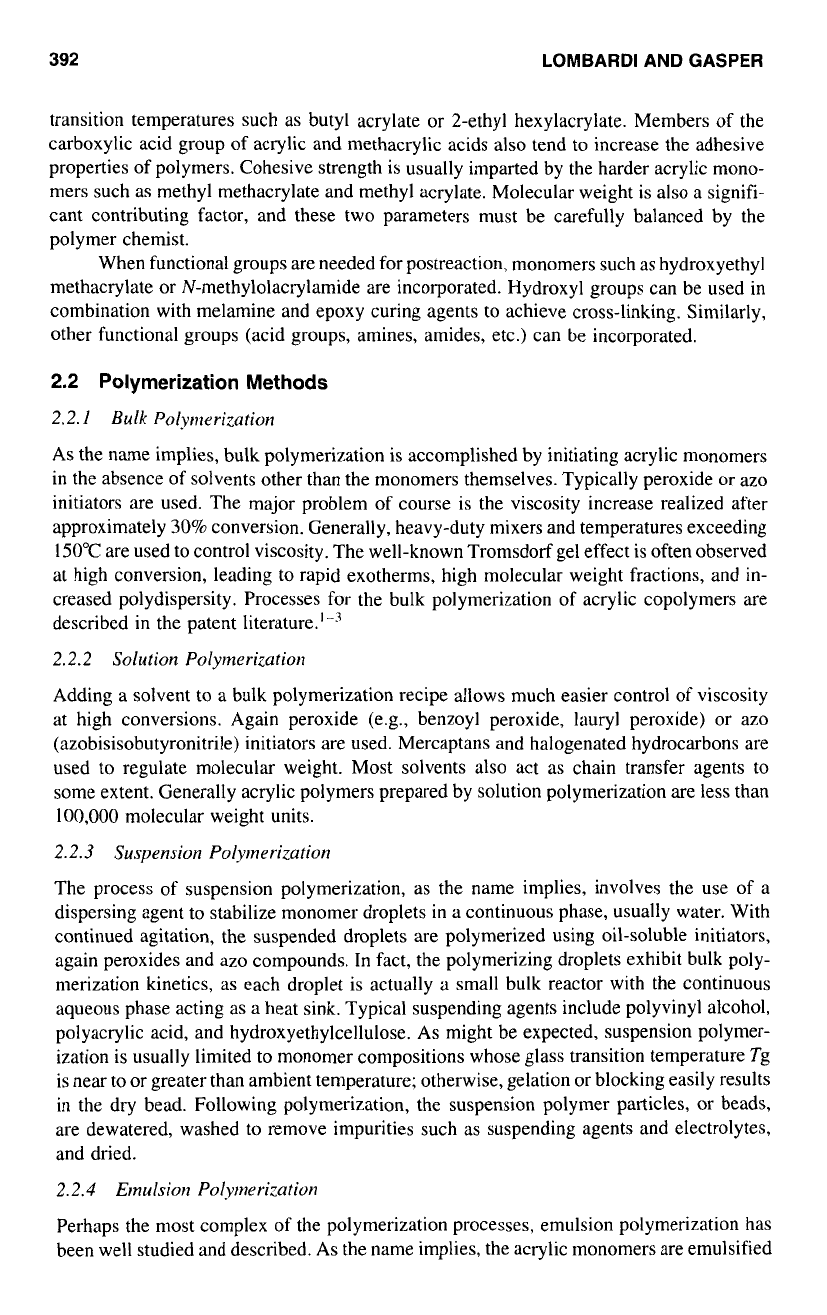
392
LOMBARD1 AND GASPER
transition temperatures such as butyl acrylate or 2-ethyl hexylacrylate. Members
of
the
carboxylic acid group of acrylic and methacrylic acids also tend to increase the adhesive
properties
of
polymers. Cohesive strength is usually imparted by the harder acrylic mono-
mers such
as
methyl methacrylate and methyl acrylate. Molecular weight is also a signifi-
cant contributing factor, and these two parameters must be carefully balanced by the
polymer chemist.
When functional groups
are
needed for postreaction, monomers such as hydroxyethyl
methacrylate or N-methylolacrylamide are incorporated. Hydroxyl groups can be used in
combination with melamine and epoxy curing agents to achieve cross-linking. Similarly,
other functional groups (acid groups, amines, amides, etc.) can be incorporated.
2.2
Polymerization Methods
2.2.1
Bulk Polymerization
AS the name implies, bulk polymerization is accomplished by initiating acrylic monomers
in the absence of solvents other than the monomers themselves. Typically peroxide or azo
initiators are used. The major problem
of
course is the viscosity increase realized after
approximately
30%
conversion. Generally, heavy-duty mixers and temperatures exceeding
150°C are used to control viscosity. The well-known Tromsdorf gel effect is often observed
at high conversion, leading to rapid exotherms, high molecular weight fractions, and in-
creased polydispersity. Processes for the bulk polymerization of acrylic copolymers are
described in the patent literature."'
2.2.2
Solution Polylnerizatiorl
Adding a solvent to
a
bulk polymerization recipe allows much easier control of viscosity
at high conversions. Again peroxide (e.g., benzoyl peroxide, lauryl peroxide) or azo
(azobisisobutyronitrile)
initiators are used. Mercaptans and halogenated hydrocarbons are
used to regulate molecular weight. Most solvents also act
as
chain transfer agents
to
some extent. Generally acrylic polymers prepared by solution polymerization are less than
100,000
molecular weight units.
2.2.3
Suspension Polyrnerization
The process of suspension polymerization, as the name implies, involves the use of a
dispersing agent to stabilize monomer droplets
in
a continuous phase, usually water. With
continued agitation, the suspended droplets are polymerized using oil-soluble initiators,
again peroxides and
azo
compounds. In fact, the polymerizing droplets exhibit bulk poly-
merization kinetics,
as
each droplet is actually a small bulk reactor with the continuous
aqueous phase acting
as
a heat sink. Typical suspending agents include polyvinyl alcohol,
polyacrylic acid, and hydroxyethylcellulose. As might be expected, suspension polymer-
ization is usually limited to monomer compositions whose glass transition temperature
Tg
is near
to
or greater than ambient temperature; otherwise, gelation or blocking easily results
in the dry bead. Following polymerization, the suspension polymer particles, or beads,
are dewatered, washed to remove impurities such
as
suspending agents and electrolytes,
and dried.
2.2.4
Emulsion Polymerization
Perhaps the most complex of the polymerization processes, emulsion polymerization has
been well studied and described. As the name implies, the acrylic monomers are emulsified

ACRYLIC POLYMERS
393
using a surfactant and suspended in a continuous phase, water. Water-soluble initiators
are used
to
initiate polymerization. Some common examples are ammonium or potassium
persulfate, hydrogen peroxide, and redox pairs such
as
t-butyl hydroperoxide-sodium for-
maldehyde sulfoxylate.
Polymerization is generally thought
to
initiate in the water phase.
A
growing radical
precipitates to
a
micelle containing monomers and continues to polymerize. The growing
micelle is resupplied with fresh monomer by diffusion from monomer droplets. For
a
thorough discussion of the emulsion polymerization process, see reference
4.
3.0
VERSATILITY
OF
ACRYLICS
3.1
Glass Transition Temperature
By selection of the proper monomers, the glass transition temperature of the polymer and
therefore the likely application area can be varied. The glass transition temperature of a
polymer is the simple average value in degrees Celsius representing
a
range of temperatures
through which the polymer changes from a hard and often brittle material into one with
soft, rubberlike properties. Although these average Tg values sometimes vary with the
test method used, they are reproducible within certain limits and represent specific polymer
characteristics. The glass transition temperature is useful
as
a
guideline for softness
of
hand, low temperature flexibility, and room temperature hardness and softening point.
The glass transition temperature should be used to compare hardness and softness of latex
only within a simple polymer group.'
Table
1
illustrates the wide range in Tg resulting from different monomer composi-
tions.
3.2
Emulsion Acrylics
Emulsions have become the dominant technology
in
acrylic polymers, and we therefore
focus much
of
our discussion on this category. Table
2
correlates Tg ranges of emulsion
acrylics with specific application areas. There is obviously overlap to be expected among
the ranges. By varying the monomer compositions, we have
a
clear indication of the
versatility
of
acrylics.
The wide range for adhesives encompasses pressure-sensitive polymers and heat
activating polymers, which dry to a tack-free state.
Table
1
Glass Transition Temperature
Homopolymer
TE
("C)
Acrylic acid
112
Methyl methacrylate 106
Methyl acrylate
8
Isopropyl acrylate
-8
Ethyl acrylate
-
24
N-Butyl acrylate
-
56
2-Ethyl hexylacrylate
-
65
Solrrce:
Ret'.
6.

394
LOMBARD1 AND GASPER
Table
2
Glass Transition Temperature Versus Application Area
Tg
("C)
Suggcsted application area
80-
100
High heat resistant coatings
50-65
Floor care coatings
35-50
General
industrial
coatings
10-40
Decorative paints
25-35
Binders for inks
-
60-25
Adhesives
3.2.
l
Physical Properties
On a physical basis, emulsions can be characterized
in
the following fundamental areas:
solids content, viscosity, pH, particle size, minimum film forming temperature
(MFT),
and particle charge.
Solids content is determined by drying latex
to
constant weight, viscosity is deter-
mined by use of the Brookfield Viscometer, and pH is determined by pH meter. Particle
size usually ranges from about
0.05
to
0.5
km, depending
on
the type and amount of
surfactant employed; measurement is usually made by laser light scattering technique,
electron microscopy, or ultracentrifuge.
Particle charge is discussed
in
the paragraphs that follow.
As
mentioned previously, surfactants stabilize liquid monomer droplets formed by
agitation. Polymerization takes place
in
monomer micelles to form the solid dispersed
particles of polymer in water. Surfactants are classified into three types: anionic, nonionic,
and cationic.'
The most common type, anionics, ionize in water to leave a negative charge on the
latex particle. Nonionics do not ionize but stabilize by a combination of hydrophobic and
hydrophilic regions on the molecule. Cationics, which are not commonly used, ionize
to
give the particle a positive charge.x
Surfactants help to improve mechanical and chemical stability of the emulsions but
also tend to increase the water sensitivity of the dried film.
Unlike solution polymers, which have one homogeneous phase, emulsions are polymer
particles dispersed
in
water, the continuous phase. Upon drying, the particles must combine
or coalesce
to
form a continuous film.
If
the process is carried out at room temperature
(25°C)
with a polymer whose Tg is above 25"C, film formation will not occur. In this
case the polymer must be heated to above its Tg or
a
coalescing agent must be added to
the latex to soften or plasticize the particles
so
that they will combine to form a continuous
film. Coalescents often used are high boiling liquids that have
a
solvating effect on the
polymer but later evaporate
so
that the full physical properties of the polymer alone are
achieved. Generically many of these coalescents are classified as glycol ethers. Their
relative toxicology has recently been studied."
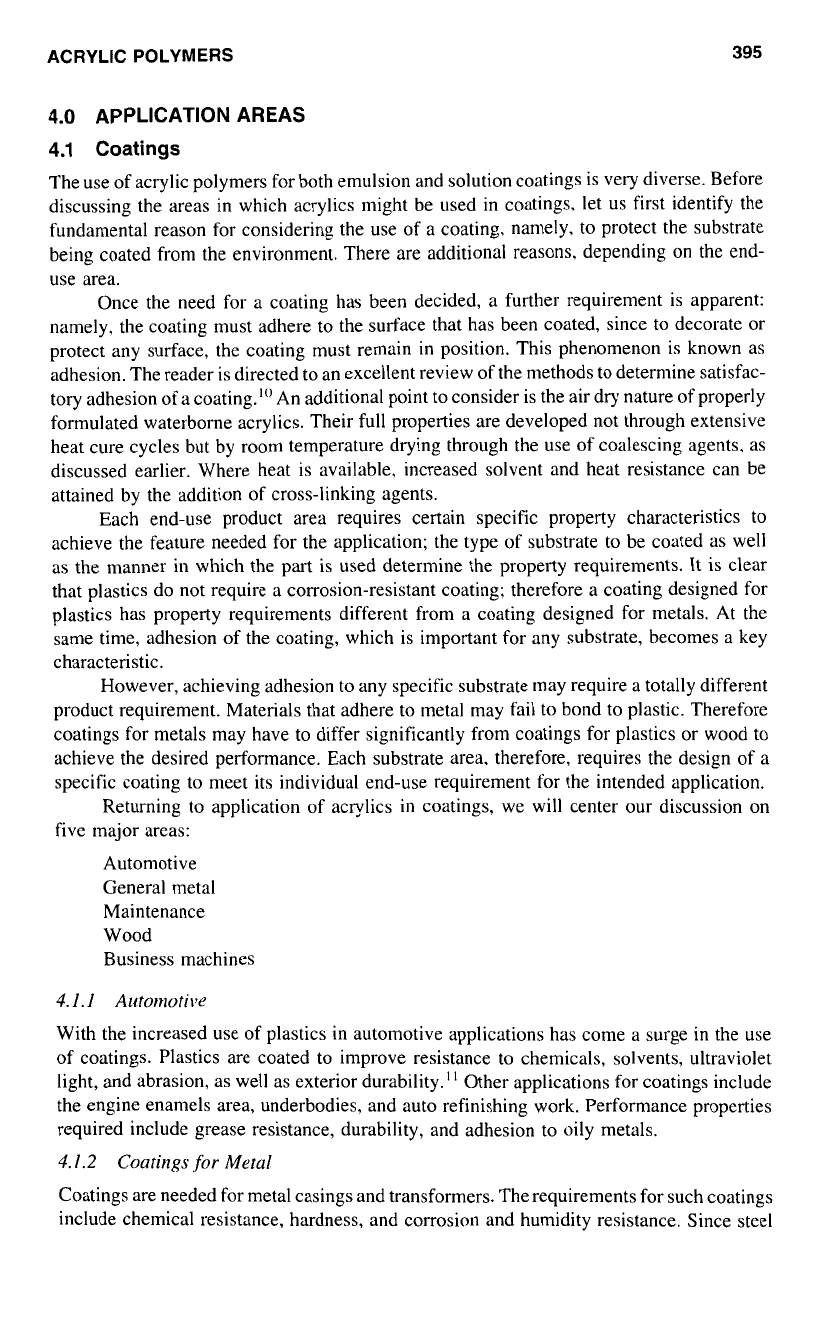
ACRYLIC
POLYMERS
395
4.0
APPLICATION AREAS
4.1
Coatings
The use of acrylic polymers for both emulsion and solution coatings is very diverse. Before
discussing the areas in which acrylics might be used in coatings, let us first identify the
fundamental reason for considering the use of a coating, namely,
to
protect the substrate
being coated from the environment. There are additional reasons, depending on the end-
use area.
Once the need for a coating has been decided, a further requirement is apparent:
namely, the coating must adhere to the surface that has been coated, since
to
decorate or
protect any surface, the coating must remain in position. This phenomenon is known as
adhesion. The reader is directed
to
an excellent review of the methods
to
determine satisfac-
tory adhesion
of
a coating."' An additional point to consider is the air dry nature of properly
formulated waterborne acrylics. Their full properties are developed not through extensive
heat cure cycles but by room temperature drying through the use of coalescing agents. as
discussed earlier. Where heat is available, increased solvent and heat resistance can be
attained by the addition of cross-linking agents.
Each end-use product area requires certain specific property characteristics to
achieve the feature needed for the application; the type of substrate
to
be coated as well
as
the manner in which the part is used determine the property requirements. It
is
clear
that plastics do not require a corrosion-resistant coating; therefore a coating designed for
plastics has property requirements different from a coating designed for metals. At the
same time, adhesion of the coating, which is important for any substrate, becomes a key
characteristic.
However, achieving adhesion
to
any specific substrate may require a totally different
product requirement. Materials that adhere
to
metal may fail
to
bond to plastic. Therefore
coatings for metals may have
to
differ significantly from coatings for plastics or wood to
achieve the desired performance. Each substrate area, therefore, requires the design of a
specific coating to meet its individual end-use requirement for the intended application.
Returning
to
application of acrylics
in
coatings, we will center our discussion on
five major areas:
Automotive
General metal
Maintenance
Wood
Business machines
4.1.1 Automotive
With the increased use of plastics in automotive applications has come a surge in the use
of coatings. Plastics are coated
to
improve resistance
to
chemicals, solvents, ultraviolet
light, and abrasion, as well as exterior durability." Other applications for coatings include
the engine enamels area, underbodies, and auto refinishing work. Performance properties
required include grease resistance, durability, and adhesion
to
oily metals.
4.1.2
Coatings
for
Metal
Coatings are needed for metal casings and transformers. The requirements for such coatings
include chemical resistance, hardness, and corrosion and humidity resistance. Since steel
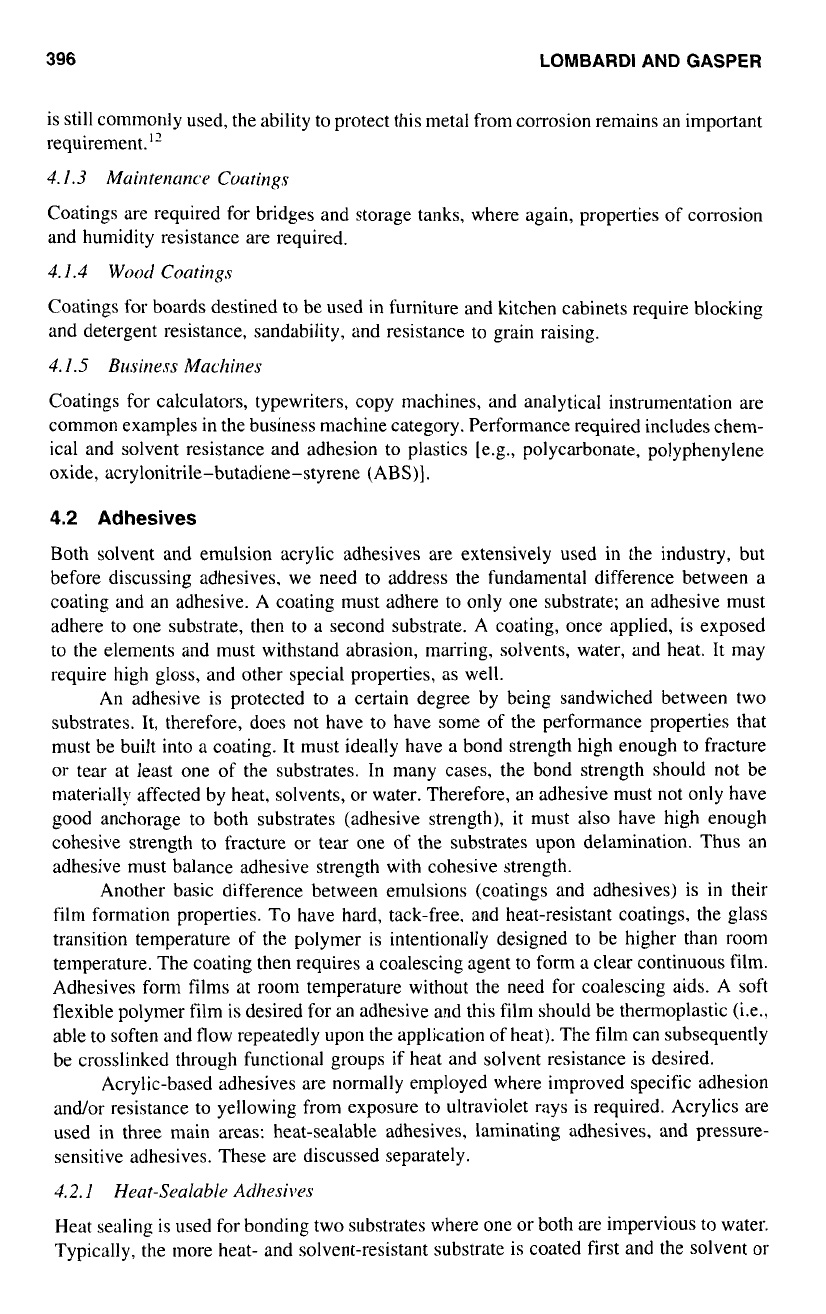
396
LOMBARD1 AND GASPER
is still commonly used, the ability to protect this metal from corrosion remains an important
requirement.''
4.1.3
Maintenmm Coatings
Coatings are required for bridges and storage tanks, where again, properties of corrosion
and humidity resistance are required.
4. l
.4
Wood
Coatings
Coatings for boards destined to be used in furniture and kitchen cabinets require blocking
and detergent resistance, sandability, and resistance to grain raising.
4.1.5
Bwitless
Machines
Coatings for calculators, typewriters, copy machines, and analytical instrumentation are
common examples
in
the business machine category. Performance required includes chem-
ical and solvent resistance and adhesion to plastics [e.g., polycarbonate, polyphenylene
oxide, acrylonitrile-butadiene-styrene (ABS)].
4.2
Adhesives
Both solvent and emulsion acrylic adhesives are extensively used in the industry, but
before discussing adhesives, we need
to
address the fundamental difference between a
coating and an adhesive. A coating must adhere to only one substrate; an adhesive must
adhere to one substrate, then
to
a second substrate. A coating, once applied, is exposed
to the elements and must withstand abrasion, marring, solvents, water, and heat. It may
require high
gloss,
and other special properties, as well.
An adhesive is protected to a certain degree by being sandwiched between two
substrates. It, therefore, does not have
to
have some
of
the performance properties that
must be built into
a
coating. It must ideally have a bond strength high enough to fracture
or tear at least one
of
the substrates. In many cases, the bond strength should not be
materially affected by heat, solvents, or water. Therefore, an adhesive must not only have
good anchorage to both substrates (adhesive strength), it must also have high enough
cohesive strength to fracture or tear one
of
the substrates upon delamination. Thus an
adhesive must balance adhesive strength with cohesive strength.
Another basic difference between emulsions (coatings and adhesives) is in their
film formation properties. To have hard, tack-free. and heat-resistant coatings, the glass
transition temperature of the polymer is intentionally designed to be higher than room
temperature. The coating then requires a coalescing agent to form a clear continuous film.
Adhesives form films at room temperature without the need for coalescing aids. A soft
flexible polymer film is desired for an adhesive and this film should be thermoplastic (i.e.,
able to soften and flow repeatedly upon the application of heat). The film can subsequently
be crosslinked through functional groups if heat and solvent resistance is desired.
Acrylic-based adhesives are normally employed where improved specific adhesion
andor resistance to yellowing from exposure
to
ultraviolet rays is required. Acrylics are
used in three main areas: heat-sealable adhesives, laminating adhesives, and pressure-
sensitive adhesives. These are discussed separately.
4.2.1
Heat-Sealable Adhesiws
Heat sealing is used for bonding two substrates where one or both are impervious to water.
Typically, the more heat- and solvent-resistant substrate is coated first and the solvent or
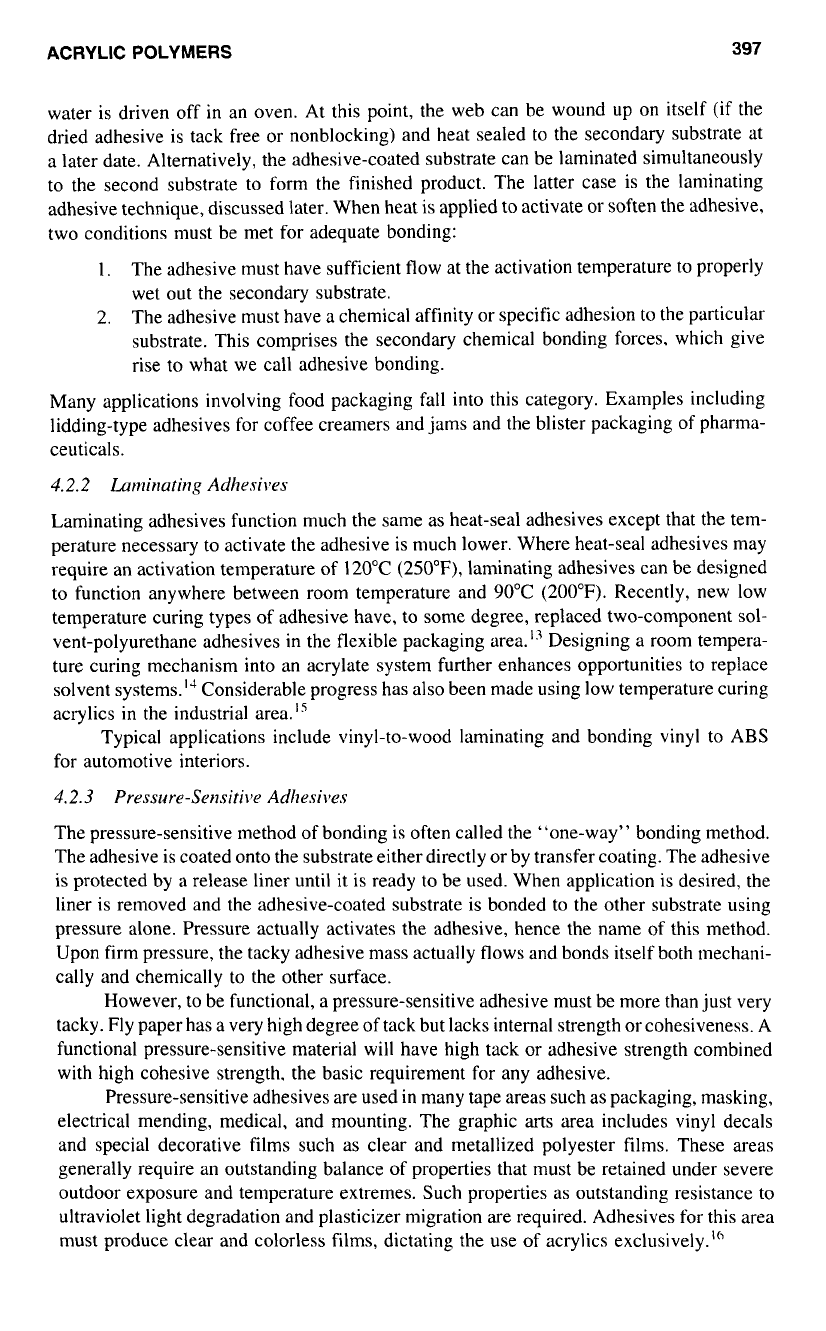
ACRYLIC POLYMERS
397
water is driven off in an oven. At this point, the web can be wound
UP
on itself (if the
dried adhesive is tack free or nonblocking) and heat sealed to the secondary substrate at
a later date. Alternatively, the adhesive-coated substrate can be laminated simultaneously
to the second substrate to form the finished product. The latter case is the lanlinating
adhesive technique, discussed later. When heat is applied to activate or soften the adhesive,
two conditions must be met for adequate bonding:
1.
The adhesive must have sufficient flow at the activation temperature to properly
wet out the secondary substrate.
2.
The adhesive must have
a
chemical affinity or specific adhesion to the particular
substrate. This comprises the secondary chemical bonding forces, which give
rise to what we call adhesive bonding.
Many applications involving food packaging fall into this category. Examples including
lidding-type adhesives for coffee creamers and jams and the blister packaging of pharma-
ceuticals.
4.2.2
Lurnir~ating Adlwsives
Laminating adhesives function much the same as heat-seal adhesives except that the tem-
perature necessary to activate the adhesive is much lower. Where heat-seal adhesives may
require an activation temperature
of
120°C
(250"F),
laminating adhesives can be designed
to function anywhere between room temperature and
90°C (200°F).
Recently, new
low
temperature curing types
of
adhesive have, to some degree, replaced two-component
sol-
vent-polyurethane adhesives in the flexible packaging area.I3 Designing
a
room tempera-
ture curing mechanism into an acrylate system further enhances opportunities to replace
solvent systems.I4 Considerable progress has also been made using low temperature curing
acrylics in the industrial area."
Typical applications include vinyl-to-wood laminating and bonding
vinyl
to ABS
for automotive interiors.
4.2.3
Pressure-Sensiti~le Adhesives
The pressure-sensitive method of bonding is often called the "one-way" bonding method.
The adhesive is coated onto the substrate either directly or by transfer coating. The adhesive
is protected by
a
release liner until it is ready to be used. When application is desired, the
liner is removed and the adhesive-coated substrate is bonded to the other substrate using
pressure alone. Pressure actually activates the adhesive, hence the name
of
this method.
Upon firm pressure, the tacky adhesive mass actually flows and bonds itself both mechani-
cally and chemically to the other surface.
However, to be functional,
a
pressure-sensitive adhesive must be more than just very
tacky. Fly paper has a very high degree of tack but lacks internal strength or cohesiveness.
A
functional pressure-sensitive material will have high tack or adhesive strength combined
with high cohesive strength. the basic requirement for any adhesive.
Pressure-sensitive adhesives are used in many tape areas such as packaging, masking,
electrical mending, medical, and mounting. The graphic
arts
area includes vinyl decals
and special decorative films such as clear and metallized polyester films. These areas
generally require an outstanding balance
of
properties that must be retained under severe
outdoor exposure and temperature extremes. Such properties as outstanding resistance
to
ultraviolet light degradation and plasticizer migration are required. Adhesives for this area
must produce clear and colorless films, dictating the use
of
acrylics exclusively.'"
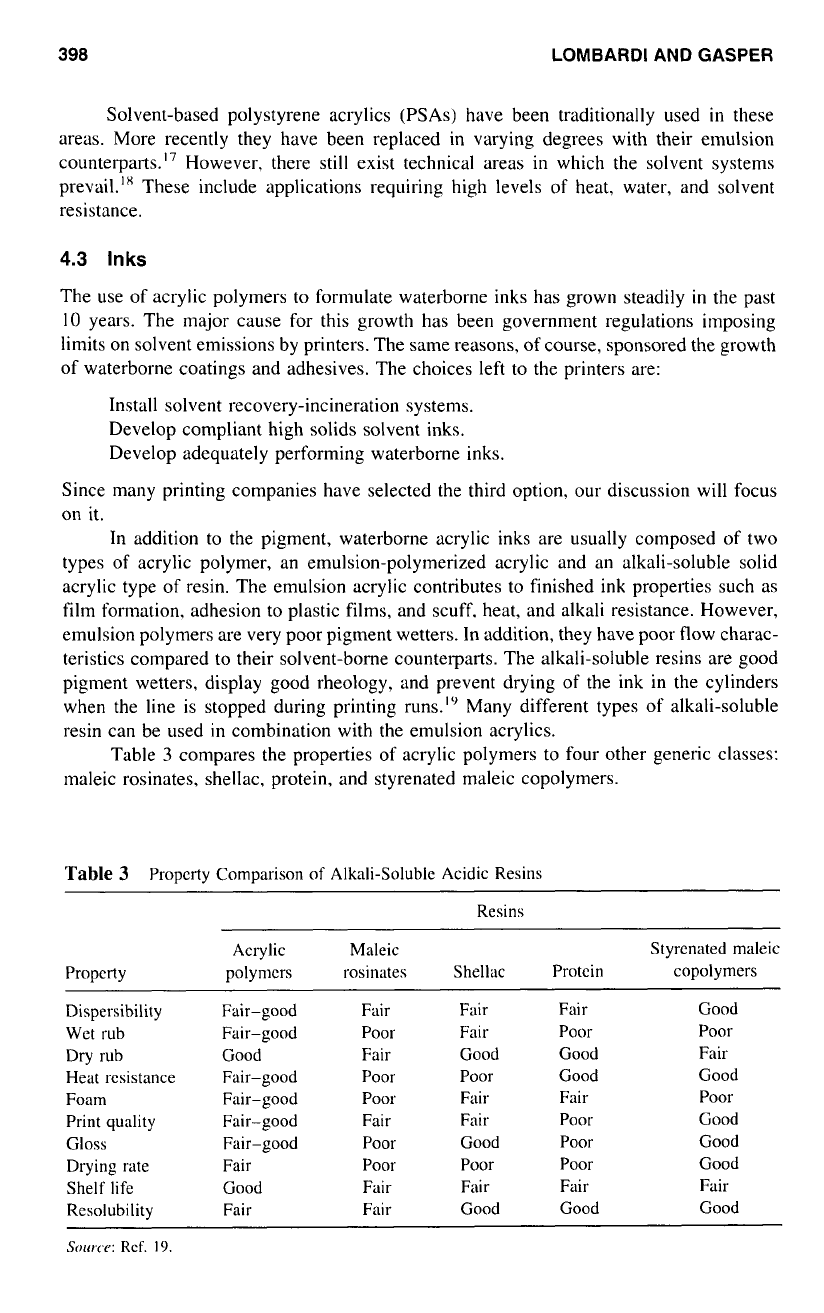
398
LOMBARD1 AND GASPER
Solvent-based polystyrene acrylics
(PSAs)
have been traditionally used
in
these
areas. More recently they have been replaced in varying degrees with their emulsion
counterparts.” However, there still exist technical areas in which the solvent systems
prevail.Ix These include applications requiring high levels of heat, water, and solvent
resistance.
4.3
Inks
The use of acrylic polymers
to
formulate waterborne inks has grown steadily
in
the past
IO
years. The major cause for this growth has been government regulations imposing
limits on solvent emissions by printers. The same reasons,
of
course, sponsored the growth
of waterborne coatings and adhesives. The choices left to the printers are:
Install solvent recovery-incineration systems.
Develop compliant high solids solvent inks.
Develop adequately performing waterborne inks.
Since many printing companies have selected the third option, our discussion will focus
on it.
In addition to the pigment, waterborne acrylic inks are usually composed of two
types of acrylic polymer, an emulsion-polymerized acrylic and an alkali-soluble solid
acrylic type of resin. The emulsion acrylic contributes to finished ink properties such as
film formation, adhesion to plastic films, and scuff, heat, and alkali resistance. However,
emulsion polymers are very poor pigment wetters. In addition, they have poor
flow
charac-
teristics compared to their solvent-borne counterparts. The alkali-soluble resins are good
pigment wetters, display good rheology, and prevent drying
of
the ink in the cylinders
when the line is stopped during printing runs.“’ Many different types
of
alkali-soluble
resin can be used in combination with the emulsion acrylics.
Table
3
compares the properties
of
acrylic polymers to four other generic classes:
maleic rosinates, shellac, protein, and styrenated maleic copolymers.
Table
3
Propcrty Comparison of Alkali-Soluble Acidic Resins
Resins
Acrylic Maleic Styrcnated maleic
Propcrty polymcrs rosinates Shellac Protcin copolymers
Dispersibility
Fair-good
Fair
Fair
Fair
Good
Wet rub
Fair-good
Poor
Fair
Poor
Poor
Dry rub Good
Fair Good
Good
Fair
Heat rcsistance
Fair-good
Poor
Poor
Good
Good
Foam
Fair-good
Poor Fair
Fair
Poor
Print quality Fair-good
Fair
Fair
Poor
Good
Drying rate
Fair
Poor Poor
Poor
Good
Shelf life Good
Fair Fair
Fair
Fair
Resolubility
Fair
Fair Good
Good
Good
Solrrcc,:
Rcf.
19.
Gloss Fair-good Poor Good Poor Good
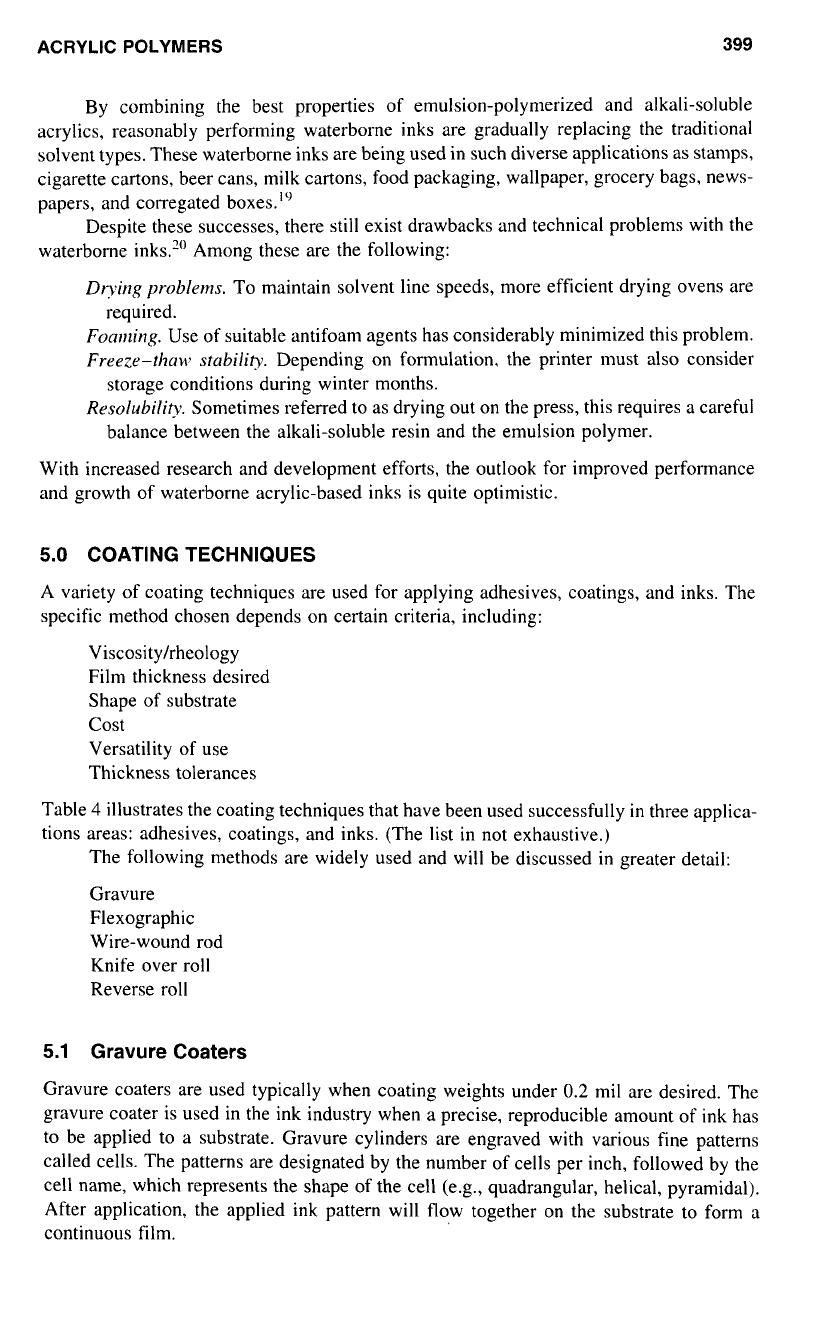
ACRYLIC POLYMERS
399
By combining the best properties of emulsion-polymerized and alkali-soluble
acrylics, reasonably performing waterborne inks are gradually replacing the traditional
solvent types. These waterborne inks are being used in such diverse applications as stamps,
cigarette cartons, beer cans, milk cartons, food packaging, wallpaper, grocery bags, news-
papers, and corregated boxes.'"
Despite these successes, there still exist drawbacks and technical problems with the
waterborne inks."' Among these are the following:
Drying pr-oblerns.
To maintain solvent line speeds, more efficient drying ovens are
Foaming.
Use of suitable antifoam agents has considerably minimized this problem.
Freeze-thaw
stabilify.
Depending on formulation. the printer must also consider
Resolubility.
Sometimes referred to
as
drying out
on
the press, this requires a careful
required.
storage conditions during winter months.
balance between the alkali-soluble resin and the emulsion polymer.
With increased research and development efforts, the outlook for improved performance
and growth
of
waterborne acrylic-based inks is quite optimistic.
5.0
COATING TECHNIQUES
A variety of coating techniques are used for applying adhesives, coatings, and inks. The
specific method chosen depends
on
certain criteria, including:
Viscosity/rheology
Film thickness desired
Shape
of
substrate
cost
Versatility of use
Thickness tolerances
Table
4
illustrates the coating techniques that have been used successfully in three applica-
tions areas: adhesives, coatings, and inks. (The list in not exhaustive.)
The following methods are widely used and will be discussed in greater detail:
Gravure
Flexographic
Wire-wound rod
Knife over roll
Reverse roll
5.1
Gravure Coaters
Gravure coaters are used typically when coating weights under
0.2
mil are desired. The
gravure coater is used in the ink industry when
a
precise, reproducible amount of
ink
has
to
be applied to
a
substrate. Gravure cylinders are engraved with various fine patterns
called cells. The patterns are designated by the number of cells per inch, followed by the
cell name, which represents the shape of the cell (e.g., quadrangular, helical, pyramidal).
After application, the applied ink pattern will flow together on the substrate to form
a
continuous film.
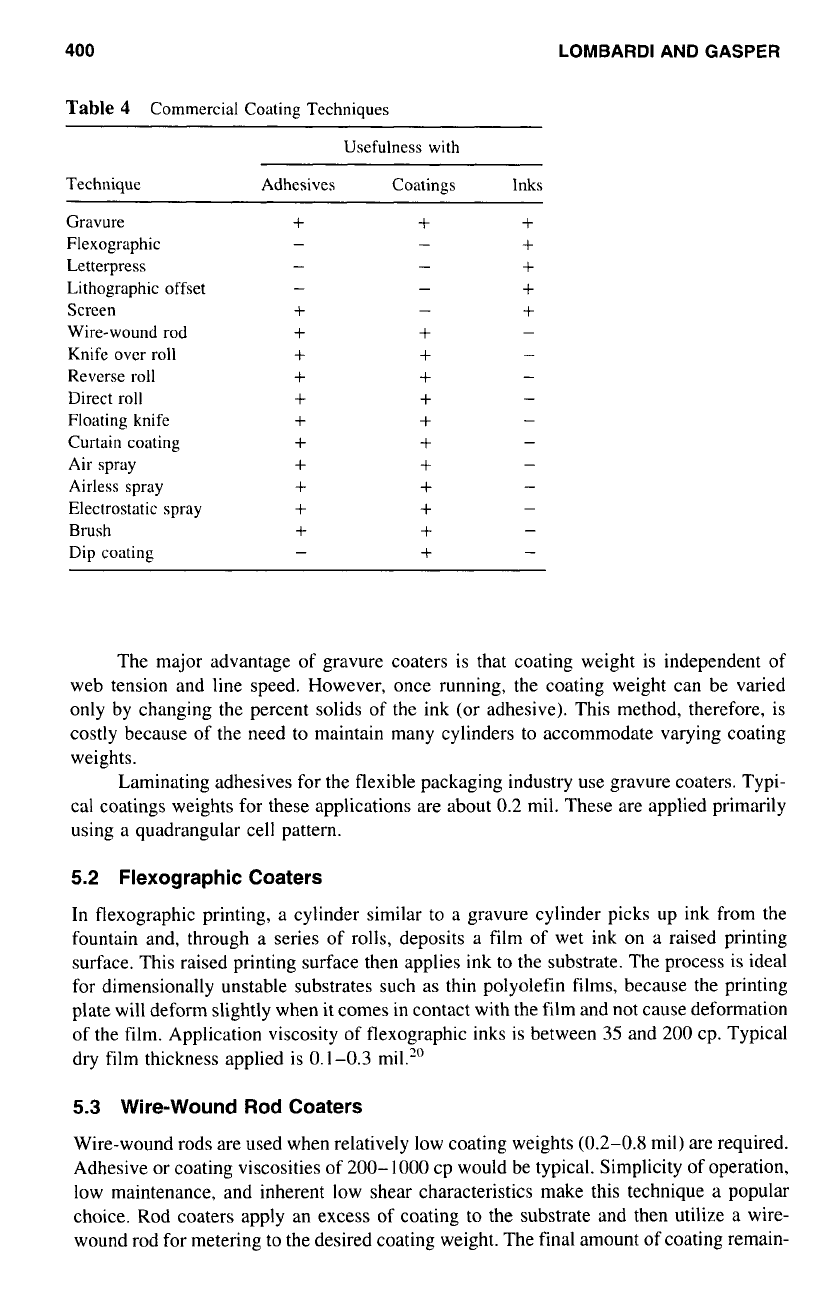
400
LOMBARD1
AND
GASPER
Table
4
Commercial Coating Techniques
Usefulness with
Technique Adhesives Coatings Inks
Gravure
Flexographic
Letterpress
Lithographic offset
Scrcen
Wire-wound rod
Knife over
roll
Reverse roll
Direct roll
Floating knife
Curtain coating
Air spray
Airless spray
Electrostatic spray
Brush
Dip coating
+
+
+
+
+
+
+
+
+
+
+
+
+
+
+
+
+
+
+
+
+
+
+
+
The major advantage of gravure coaters is that coating weight is independent of
web tension and line speed. However, once running, the coating weight can be varied
only by changing the percent solids of
the
ink (or adhesive). This method, therefore, is
costly because of the need
to
maintain many cylinders to accommodate varying coating
weights.
Laminating adhesives for the flexible packaging industry use gravure coaters. Typi-
cal coatings weights for these applications are about
0.2
mil. These are applied primarily
using a quadrangular cell pattern.
5.2
Flexographic Coaters
In flexographic printing, a cylinder similar to a gravure cylinder picks up ink from the
fountain and, through a series of rolls, deposits a film
of
wet ink on a raised printing
surface. This raised printing surface then applies ink
to
the substrate. The process is ideal
for dimensionally unstable substrates such as thin polyolefin films, because the printing
plate will deform slightly when it comes in contact with the film and not cause deformation
of the film. Application viscosity of flexographic inks is between
35
and
200
cp. Typical
dry film thickness applied is
0.1-0.3
mil.'"
5.3
Wire-Wound Rod Coaters
Wire-wound rods are used when relatively low coating weights
(0.2-0.8
mil) are required.
Adhesive or coating viscosities of
200-1000
cp would be typical. Simplicity of operation,
low maintenance, and inherent low shear characteristics make this technique a popular
choice. Rod coaters apply an excess of coating to the substrate and then utilize a wire-
wound rod for metering to the desired coating weight. The final amount of coating remain-
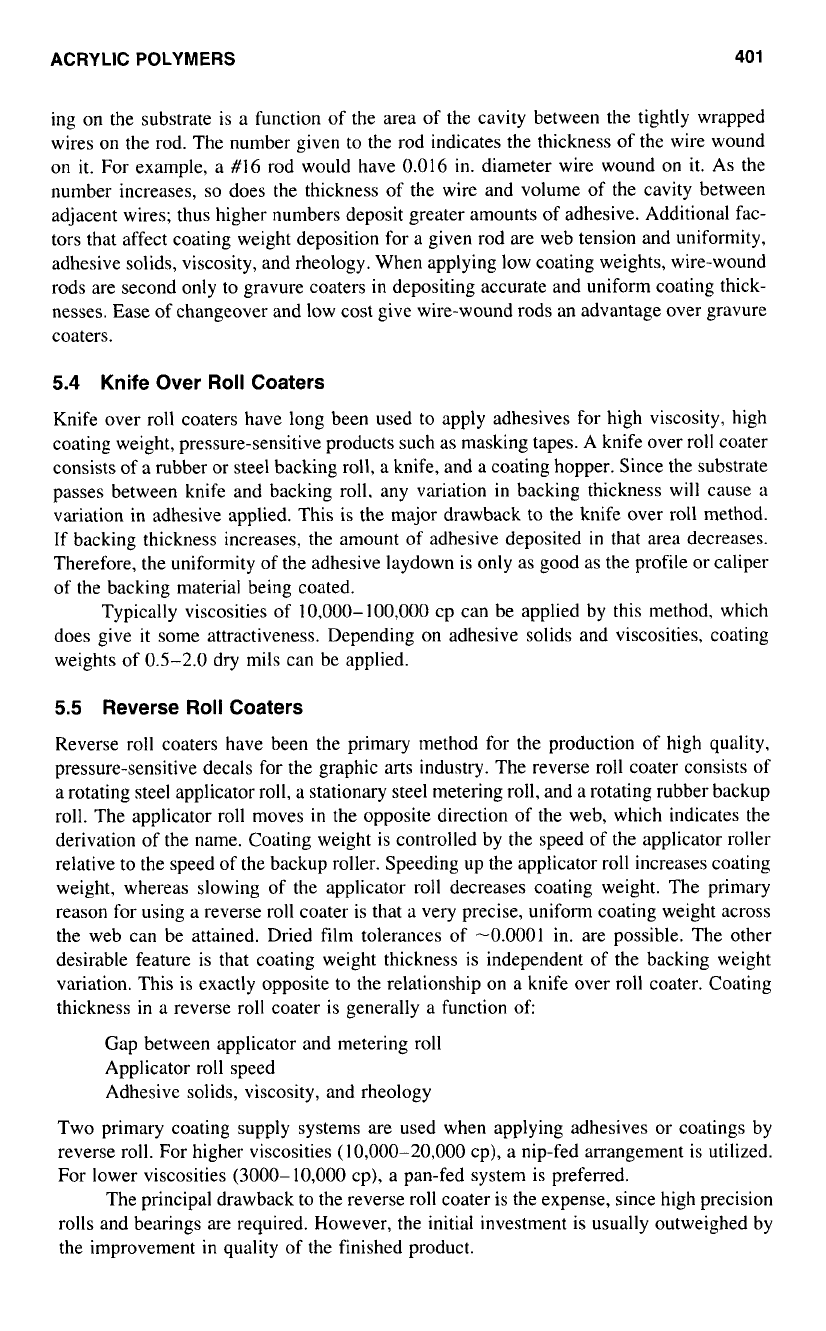
ACRYLIC POLYMERS
401
ing on the substrate is a function of the area
of
the cavity between the tightly wrapped
wires on the rod. The number given to the rod indicates the thickness
of
the wire wound
on
it.
For example, a
#l6
rod would have
0.016
in. diameter wire wound on it. As the
number increases,
so
does the thickness of the wire and volume of the cavity between
adjacent wires; thus higher numbers deposit greater amounts
of
adhesive. Additional fac-
tors that affect coating weight deposition for a given rod are web tension and uniformity,
adhesive solids, viscosity, and rheology. When applying low coating weights, wire-wound
rods are second only to gravure coaters in depositing accurate and uniform coating thick-
nesses. Ease of changeover and low cost give wire-wound rods an advantage over gravure
coaters.
5.4
Knife Over
Roll
Coaters
Knife over roll coaters have long been used to apply adhesives for high viscosity, high
coating weight, pressure-sensitive products such as masking tapes. A knife over roll coater
consists of a rubber or steel backing roll,
a
knife, and a coating hopper. Since the substrate
passes between knife and backing roll. any variation
in
backing thickness will cause a
variation in adhesive applied. This is the major drawback to the knife over roll method.
If backing thickness increases, the amount of adhesive deposited
in
that area decreases.
Therefore, the uniformity of the adhesive laydown is only as good as the profile or caliper
of the backing material being coated.
Typically viscosities
of
10,000-100,000
cp can be applied by this method, which
does give
it
some attractiveness. Depending on adhesive solids and viscosities, coating
weights of
0.5-2.0
dry mils can be applied.
5.5
Reverse
Roll
Coaters
Reverse roll coaters have been the primary method for the production of high quality,
pressure-sensitive decals for the graphic arts industry. The reverse roll coater consists of
a rotating steel applicator
roll,
a stationary steel metering roll, and a rotating rubber backup
roll. The applicator roll moves
in
the opposite direction of the web, which indicates the
derivation of the name. Coating weight is controlled by the speed of the applicator roller
relative to the speed
of
the backup roller. Speeding up the applicator roll increases coating
weight, whereas slowing of the applicator roll decreases coating weight. The primary
reason for using a reverse roll coater is that a very precise, uniform coating weight across
the web can be attained. Dried film tolerances
of
-0.0001
in. are possible. The other
desirable feature is that coating weight thickness is independent of the backing weight
variation. This is exactly opposite to the relationship on a knife over roll coater. Coating
thickness
in
a
reverse roll coater is generally a function
of
Gap between applicator and metering roll
Applicator roll speed
Adhesive solids, viscosity, and rheology
Two primary coating supply systems are used when applying adhesives or coatings by
reverse roll. For higher viscosities
(10,000-20,000
cp), a nip-fed arrangement is utilized.
For lower viscosities
(3000-
10,000
cp), a pan-fed system is preferred.
The principal drawback to the reverse roll coater is the expense, since high precision
rolls and bearings are required. However, the initial investment is usually outweighed by
the improvement in quality of the finished product.
